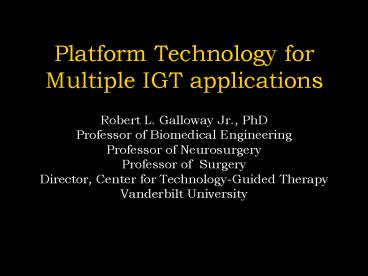Platform Technology for Multiple IGT applications - PowerPoint PPT Presentation
1 / 26
Title:
Platform Technology for Multiple IGT applications
Description:
Cochlear Implants. Applications of TGT. Kidney Surgery. Lung Therapy ... Cochlear Implants. Robotic Image-Guided Surgery. Direct Injection Gene Therapy. Orion ... – PowerPoint PPT presentation
Number of Views:59
Avg rating:3.0/5.0
Title: Platform Technology for Multiple IGT applications
1
Platform Technology for Multiple IGT applications
- Robert L. Galloway Jr., PhD
- Professor of Biomedical Engineering
- Professor of Neurosurgery
- Professor of Surgery
- Director, Center for Technology-Guided Therapy
- Vanderbilt University
2
Disclosure
Bob Galloway is the founder of , and retains an
equity position in, Pathfinder Therapeutics Inc,
of Nashville, TN
3
Technology-Guided Therapy
Mechanical Data
Thermal Data
Optical Data
Neuroprosthesis
Radiation Therapy
Surgical Resection
Ablation Tech niques
Ortho pedics
External Beam Radiation
Intra- Operative Imaging
Image-Guided Surgery
Preoperative Images
Image-Guided Procedures
Image-Guided Interventions
Tissue Models
Gene Therapy
4
History of Image-Guided Therapy
- 1896 J.H. Clayton. X-Ray use in surgery
- 1904 Horsley and Clarke. Stereotactic frame
- 1946 Spiegel and Wycis. Stereotactic frame using
xrays. - 1940s1950s Leksell, Riechert-Mundinger,
Talairach, Cooper...
TGT
5
Technology-Guided Therapy Timeline
- 1986
- Roberts et al. A frameless stereotaxic
integration of computerized tomographic imaging
and the operating microscope, J. Neurosurg, 65,
545, 1986. - 1987
- A three dimensional guidance system for
stereotactic neurosurgery. Proposal to the
Whitaker Foundation RL Galloway PI - Watanabe et al. Three-dimensional digitizer
(neuronavigator) new equipment for computed
tomography-guided stereotaxic surgery
Surg-Neurol, 27, 1987
6
Technology-Guided Therapy Timeline
- 1997 (Vanderbilt)
- Discussions begin about applying IIGS techniques
to other organs - Discussions begin about software redesign (Orion)
- Abstract the TGT process
- Software Architecture
- Speed of Performance
- Avoidance of software bloat
- Minimize the effect of the Law of Unintended
Consequences
7
Software Design
- Fundamental concepts
- Basic requirements
- Task list
- Methodology
- Workflow assessment
- Information and data flow
- Task Organization
- Software Organization
8
Fundamental Concepts for TGT Software
- In designing image-guided therapeutic devices, we
accept responsibility for the patients care. - The responsibility must be ours.
- Mission critical engineering is evaluated not on
its average performance but on its worst case
performance. - Nobody dies in image space
TGT
9
Basic Requirements
- Need images and knowledge of both the information
they convey and their spatial characteristics. - Need a three (or six) dimensional tracking
system. - Need a methodology for the visualization of path,
structures and target. - Need a method of registration from physical space
to image spaces - Correction for perioperative and intraoperative
changes
TGT
10
Task List
- Localizer
- Display
- Graphics
- I/O
- Registration
- Correction
11
Methodology
- Open Architecture with defined interfaces
- DLL design for run time selection of function
- Reduces software bloat
- Allows rapid debug and leak detection
- No communication between functions with different
DLLs - Allows data encapsulization
12
Software Organization
13
New Software Design
Display
Localizer
IO
Video
Optotrak 3020
A-Mode US
Optotrak Certus
Tomogram
Polaris
LRS
Polaris Vicra
Rotational
Polhemus
Aurora
Biomechanical
2-D Images
Optical Biopsy
Claron
da Vinci
ORION
Graphic
Registration
Correction
Render
Deformation
Quaternion
Salient Feature
Biopsy
Functional
SVD
Patch
Preop Plan
HTM
ICP
Transparency
14
Applications of TGT
- Intracranial Neurosurgery
- Tumor resection
- Implantation of Neuroprostheses
- Functionally Guided Neurosurgery
- Spinal Surgery
- Liver Surgery
- Colorectal Cancer Staging and Surgery
- Ophthalmologic Surgery
- Cochlear Implants
15
Applications of TGT
- Kidney Surgery
- Lung Therapy
- Tumor resection/ablation/brachytherapy
- Prostate Therapy
- Open or robotic surgery
- Brachytherapy
- Direct injection Chemotherapy/ Gene Therapy
16
Image-Guided Neurosurgery
17
Image-Guided Liver Surgery (IGLS)
18
Spinal Surgery
Image
Guide
Confirm
19
Applications of TGT
Colorectal Cancer Staging and Surgery
- One of the most prevalent cancers in the US
- Visualization of the layered structure of the
rectum is important for staging and therapy
20
Cochlear Implantation
- Cochlear Implants
21
ORION Performance
- System boot time in the OR 15 seconds
- Number of image types Simultaneous display 4
- Number of image types OR selectable 64
- Image update (unsynched) 4 512x512 images at 63
Hz. - Point based registration lt 10 ms
- Surface based registration (liver, 20,000 points)
35 seconds
22
Orion Code Base drives (1)
- Intracranial Neurosurgery
- Tumor resection
- Implantation of Neuroprostheses
- Functionally Guided Neurosurgery
- Spinal Surgery
- Liver Surgery
- Direct injection Chemotherapy
23
Orion Code Base drives (2)
- Colorectal Cancer Staging and Surgery
- Ophthalmologic Surgery
- Cochlear Implants
- Robotic Image-Guided Surgery
- Direct Injection Gene Therapy
24
Orion Licensing
- Base program DLLs available for research
license from Vanderbilt University - Custom DLL development is available by contract
to Vanderbilt - ORION with FDA VV process available from
Pathfinder Therapeutics Inc
25
Three important challenges for the engineering of
IGT systems
- Validation
- Agreed upon accuracy metrics
- Phantom design
- Human use
- Robustness
- Sensitivity to variability
- Vertical Integration
- Will the solution work for all patients
26
Help address these challenges
- Image-Guidance is the modifier, not the driving
force. - Involve the people doing the therapy at every
step - Writing proposals
- Reviewing proposals
- Planning the protocols
- Using the systems and providing feedback
- IGS/IGT/IGP/TGT needs its own study section































